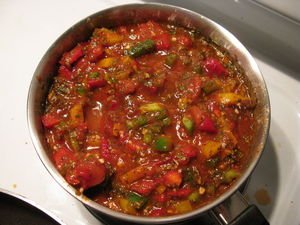The humble tomato creates so many different kinds of sauces. Ketchup, salsa, tomato paste and spaghetti sauce are all birthed by the “love apple.” Call it a fruit or a vegetable but these tomato-based sauce experiences all provide our bodies with the cancer-fighting antioxidant lycopene.
My style of passionista cooking is known in my inner circle as latchkey cooking. Yes, I wear the banner of being a latchkey chef proudly. The nickname comes from being a kid with two working parents who had to figure out her own meals after school. As a result, I can take almost any ingredients from a pantry or refrigerator and make it work. I am proud to say that I don’t only make it work, but my cooking has received rave reviews. The main benefit a latchkey chef is that I rarely look in the cabinet and feel like there’s nothing to eat.
So you have a pasta craving but all you have is a box or two of pasta and some salsa in the fridge? Don’t despair, here’s how to turn your Mexican-style salsa into Italian-style spaghetti. Isn’t it interesting how similar ingredients could yield such different outcomes?
Let’s begin with, what is salsa?
The traditional Mexican-style salsa that most of us are familiar with is generally made with tomatoes, cilantro, cumin, lime, salt, onions, garlic, oregano, black pepper and chili peppers. The word salsa in Spanish simply means sauce. Typical salsas can range in flavor from mild to spicy hot. Some recipes also include vinegar. Salsa is usually served fresh and chilled with uncooked ingredients.
What is tomato sauce?
A tomato sauce is served with any sort of Italian pasta dish from linguine and lasagna to spaghetti and ziti. The main ingredients of a pasta sauce are tomatoes, garlic, oregano, onions and basil. Meat can also be added to the sauce. The range of variations of tomato sauce is as extensive as the amount of people cooking Italian food.
If you’ve got pasta and you find a bottle of salsa in the fridge, don’t despair. You can easily turn salsa into spaghetti sauce.
1. Strike up the stove.
The main difference between the two is that pasta sauce is generally cooked while salsa is raw. Cooking the tomatoes is what gives pasta sauce that bold big bodied flavor. Dump the jar of salsa into a pan over a low simmering burner.
2. Re-spice the dish.
Sugar will cut the typical acidic taste of salsa. If you don’t have sugar, you can use honey. Add plenty of fresh garlic, basil and black pepper. This will counteract the cilantro and chili peppers for a rich flavor and texture.
3. Let it burn.
Add more tomatoes, if you can. Slow and steady wins the race when it comes to cooking a great pasta sauce. Additions like green peppers, bay leaves and rosemary all present with bolder flavor when cooked low and slow. Including lots of fresh vegetables, mozzarella and Parmesan cheese will insure that your sauce is tasty and yummy.
Now that’s passionate eating fit for a queen and her king!
More from this Contributor
Vegetarian and Vegan Eating in London! Passionate UK Veggie Eats
Do You Need a Love Contract? How to Make a Relationship Agreement
Is 25 the right age to get married?
